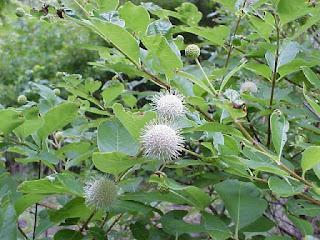 |
| Bottlebrush Buckeye in June |
Bottlebrush Buckeye really showed out in our garden this summer. Multitudes of rain fell during the month of June, and our little bushes just loved it.
Aesculus parviflora is usually referred to as Bottlebrush Buckeye because the huge blooms do resemble large white bottlebrushes. Aesculus parviflora is a lovely native plant with bright green palmately compound leaves and fragrant white bottlebrush blooms up to 1 foot long in summer.
This plant has a spreading habit that under ideal conditions will grow wider than it is tall. When I say ideal conditions, I mean moist soil in full sun. We have one such plant, pictured in this post. But Bottlebrush Buckeye is quite tolerant of drought. I know this because we have one that I should have planted in a better spot, as it has been growing in full shade with no supplemental water for years. That one is pitifully leggy and has never bloomed until this year, after all that late Spring rain we had, when it rewarded us with one bloom. I was appreciative, but apologetic. I did not know what I was doing when I planted that one.
The huge white bloom panicles on the Bottlebrush Buckeye attract butterflies and many other pollinators.
This lovely shrub can grow up to 12 feet tall and spread to about 15 feet wide.
If you are lucky enough to have a pond or a stream, that is this buckeye's native habitat. It will tolerate a constantly wet bog, but grows well in any garden with regular water. If grown in full sun, it will need more water. You'll get the largest most beautiful blooms in full sun with regular water or wet soil.










